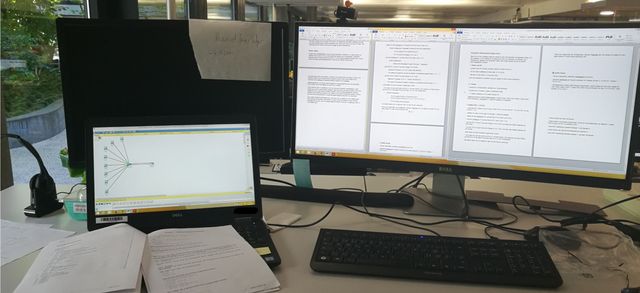Trial internship report

Jonas Sulzer
Written on June 24, 2017

Internship 06.06.2017 - 16.06.2017
At High School I got the Chance to do a two-week trial internship. We practiced during a block week to apply for it.
I'm interested in computer science since my childhood.
Since I'm already investing a lot of time and effort in my second passion
due to the fact that I have chosen to focus on music at High school,
it was clear to me to do this internship in computer science.
My interests in computer science and especially in the related
security aspects have been proven by the internship.
Preparations, expectations and first impressions of the working environment
After I had applied,
I was invited for a job interview.
I was very relieved,
when it was over.
Fortunately, it was more like getting to know each other,
than a strict job interview.
It was rather a discussion about what I would be doing during the two weeks
and which provisions apply.
Realizing how open minded and spontaneous my employer is,
Already during the conversation I became more and more relaxed.
When I inquired about IT security
he went directly to the appropriate department to ask
if someone will show me something there.
The closer my internship, the more I was looking forward to for once doing something different to the ordinary school life, knowing that I would have an interesting Job.
Tasks during the internship
The computer science trainees of the company work with my two employers for 6 - 8 weeks, to learn the basics about networks. Until now, the trainees had to work out the entire theory themselves to afterwards apply what they had learned in a laboratory environment with physical devices. During the two week I created two theoretical documents for this and for each one another document with exercises and the corresponding solutions.
In a first 14-page document "Theory of network configuration" I have summarized and explained the most important network terms: What's a Switch? What's Router? What are those doing? On which layer of the OSI reference model do they operate? What are Mac- and IP-adress? What is the Netmask needed for? What is the difference between Uni-, Multi- and Broadcast? And much more.
Since the company uses Cisco network devices and the simulation "Packet Tracer" also comes from Cisco, the corresponding commands have to be used to configure the (virtual) devices. In another 7-page document "Cisco IOS-Commands" I explain the most important commands, so that the trainees can learn how to configure the corresponding devices properly.
In addition I created nine exercises. Eight of them can be solved in the simulation. Like this, the trainees can see immediately whether the devices are configured correctly and are able to work on their own. I structured the exercises in a constructive way, so that they gradually become more difficult and complex. The last document contains the solutions including the correct approach to the exercises. In case someone should not succeed with an exercise at all, the supervisor could give him or her the documented approach.
Experience
Beside the technical experience it was the first opportunity for me to get some experience in a work environment The final report showed me that I am certainly allowed to appear a little more confident The working atmosphere was kind as well.
I was impressed in a technical way by the tour through the data processing centre in the basement floor. The safeguarding in terms of access security, batteries, emergency generator and fire protection as well as fire-fighting dispositions are fascinating.
Since I was more involved with PCs, servers and websites until now, the internship was a great opportunity for me to extend my know-how in the area of network technology. It was great for me, that I could experiment without restrictions and that I was allowed to add bugs to my laboratory network without disturbing the production network. Therefore the learning effect was huge and not only theoretical. Thanks to the simulation environment, I was not dependent on devices and still had all network components available for configuration and testing.
Reflection and conclusion
During my internship I was able to learn a lot of technical information about network technology. In a home environment the possibilities are limited, as it is non-essential to establish a large, structured network. That's why I had done very little work on this so far. Thanks to the internship I got the opportunity to deepen my knowledge and learn more about the components and functions of a network. I knew approximately what a router and what a switch are, but I could neither create different subnets nor configure the corresponding routing for it before the internship.
The half day introduction to IT-Security, where I was given the opportunity to learn how firewall rules look like, how they work, and what a web proxy actually does was also very interesting. The security specialist furthermore highlighted the problems of the email protocol and the associated security issues. I also learned in more detail about encryption.
Apart from the technical aspects, however, I was also able to gain pleasant experiences, e.g. how it is to work in an open-plan office. The employees have a good and humorous relationship with each other. I could well imagine working in such a community for a longer period of time. The atmosphere in an open-plan office is also good and quiet enough to allow you to concentrate on your work, but at the same time you are not sitting all alone in a small room.
It was also great to do something interesting and to know at the same time, that there is a meaning behind it and that what I have worked out would be used.
I could well imagine to pursue a career in computer science in future. It might even be IT security.